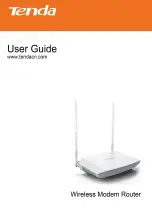
Network trace configuration
99
Network trace configuration
Overview
Network administrators can perform network traces to capture and analyze network traffic.
Network trace operates in two modes:
•
Packet file trace mode
: Captured packets are stored in a file on the M210. The M210
can transfer the file to a TFTP server. The file is formatted in pcap format and can be
examined using tools such as Wireshark and OmniPeek.
•
Remote packet trace mode
: The captured packets are redirected in real time to an
external PC running the Wireshark tool.
The AP can trace the following types of packets:
•
802.11 packets received and transmitted on radio interfaces. Packets captured on radio
interfaces include the 802.11 header.
•
802.3 packets received and transmitted on the Ethernet interface.
•
802.3 packets received and transmitted within wireless communities or on internal logical
interfaces, such as WDS interfaces.
To configure network trace settings and initiate packet captures, select
Tools
>
Network
trace
.
Packet trace configuration
Use this section to configure parameters that affect how packet trace functions on the radio
interfaces.
Trace beacons
Enable to trace the 802.11 beacons detected or transmitted by the radio. It is recommended
that you also enable Promiscuous trace when performing a beacon trace.
Promiscuous trace
Enable to place the radio in promiscuous mode when the trace is active.
In promiscuous mode, the radio receives all traffic on the channel, including traffic that is not
destined to the M210. While the radio is operating in promiscuous mode, it continues serving
associated clients. Packets not destined to the AP are not forwarded.
As soon as the trace is completed, the radio reverts to non-promiscuous mode operation.
Summary of Contents for M210
Page 6: ...6 ...
Page 30: ...30 Managing the M210 ...
Page 32: ...32 Managing the M210 ...
Page 46: ...46 Working with wireless communities and authentication ...
Page 74: ...74 Creating WDS links ...
Page 106: ...106 Tools ...
Page 110: ...110 ...












































